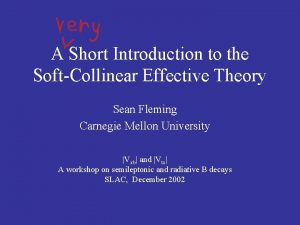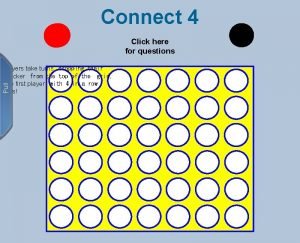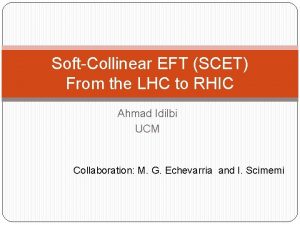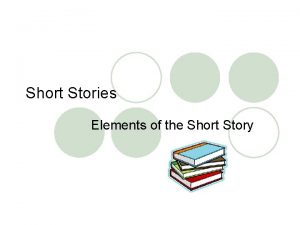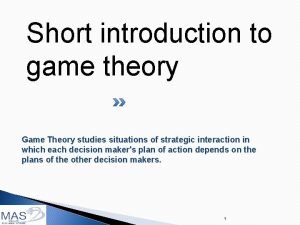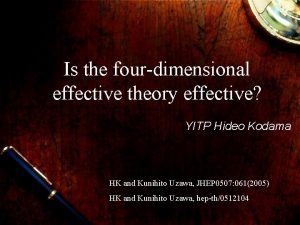A Short Introduction to the SoftCollinear Effective Theory













- Slides: 13

A Short Introduction to the Soft-Collinear Effective Theory Sean Fleming Carnegie Mellon University |Vxb| and |Vtx| A workshop on semileptonic and radiative B decays SLAC, December 2002

SCET Bauer, Fleming, Luke, Phys. Rev. D 63: 014006, 2001 Bauer, Fleming, Pirjol, Stewart, Phys. Rev. D 63: 114020, 2001 Bauer & Stewart, Phys. Lett. B 516: 134, 2001 Bauer, Pirjol, Stewart, Phys. Rev. D 65: 054022, 2002 Effective field Theory of highly energetic particles that have a small invariant mass E >> M: Near the lightcone • p = (p+, p-, p ) ~ Q(M 2/Q 2, 1, M/Q) ~ Q(l 2, 1, l) • l << 1, and p 2 ~ l 2 SCET has the right degrees of freedom for describing energetic particles interacting with soft “stuff” Analogous to HQET: Effective Field Theory of Heavy and soft degrees of freedom--describes heavy particles interacting with soft “stuff”

If you only remember one thing… Remember this picture: Heavy: HQET p B p Light and energetic: SCET describes the light and energetic particles SCET is QCD in a limit

Kinematics B p Pion momentum: p p m = (2. 640 Ge. V, 0, 0, -2. 636 Ge. V) p m m ≈Qn n = (1, 0, 0, -1) = (0, 2, 0 ) LC coordinates Corrections are small ~ LQCD , mp relative to Q • Expansion in LQCD Q or LQCD √ Q

Motivation Systematic: power counting in small parameter l Understand Factorization in a universal way § Key to separate hard contributions from soft & collinear § Systematic corrections to factorization (power counting) Symmetries § Reduce the number form-factors § In HQET where there is only the Isgur-Wise function Sum infrared logarithms § Sudakov logarithms

So…what’s it good for? SCET couple to HQET can be used for any decays involving stationary heavy, and fast light particles: B Dp, B pen, B ren, B K* g, B K e+ e- , B pp, B Kp, B Xu e n, B Xsg , U X g … DIS, Drell Yan, g*g p 0 , g p p, …

B D p factorization J. D. Bjorken: Color-transparency, Nucl. Phys. B (Proc. Suppl. ) 11, 1989, 325 Dugan & Grinstein: Factorization in LEET Phys. Lett. B 255: 583, 1991 Politzer & Wise: Factorization (proposed) Phys. Lett. B 257: 399, 1991 Beneke, Buchalla, Neubert, Sachrajda: QCD factorizaton (proved to 2 loops) Nucl. Phys. B 591: 313, 2000 Bauer, Pirjol, Stewart: SCET (proved to all orders in as) Phys. Rev. Lett. 87: 201806, 2001 Heavy: HQET p B D Light & Fast: SCET i 2 mb Ep fp FB D(0) ∫ dx T(x, m) fp(x, m) Soft B D form factor Hard coefficient calculate in PT: as(Mb) Light-cone pion wavefunction: nonperturbative

Semi-leptonic heavy-to-light Selected history: Brodsky et. al. (1990) Li & Yu (1996) Bagan, Ball, Braun (1997) Charles et. al. (1998) Beneke & Feldman (2000) Bauer et. al. (2000) Descotes, Sachradja (2001) Bauer, Pirjol, Stewart (2002) Pirjol & Stewart (2002) Hard part, 1/x 2 singularity k. T factorization, Sudakov suppression Light-cone sum rules Symmetry relations: z(E), z||(E) O(as) corrections, factorization proposal Collinear gluons, Ci(P), soft factorization More on Sudakov suppression Factorization in SCET Details of factorization in SCET

Semi-leptonic heavy-to-light e. g. B r l n at large recoil r B n } q 2 HQET SCET factorization: all orders in as, leading order in l: F(M 2) = 12 f. B f. M Bauer, Pirjol. Stewart: hep-ph/0211069 ∫ dz ∫ dx ∫ dr+ T(z, M, m 0) J(z, x, r+, M, m 0, m) j. M(x, m) j. B+(r+, m) + Ck(M, m) xk(q, m) Non-factorizable piece Non-perturbative form factors (restricted by symmetries in SCET) Factorizable piece Non-perturbative parameters: decay constants, LC wave functions Note both the pieces are same order in power counting!

B r l n: Q 2 range where SCET is valid mr = 770 Mev Remember for SCET to be valid we need Q >> LQCD , mr Q 2 (Ge. V 2) 0 0. 25 1 E (Ge. V) 2. 70 2. 67 2. 60 P (Ge. V) 2. 58 2. 56 2. 48 2. 25 4 6. 25 2. 48 2. 32 2. 10 2. 36 2. 19 1. 96 mr /E or mr /2 E 0. 286 0. 143 0. 288 0. 144 0. 300 0. 150 0. 310 0. 330 0. 360 0. 155 0. 165 0. 180 Too Big? !? !

Heavy-to-light factorization in SCET: Details F(Q 2) = ∫ dz ∫ dx ∫ dr+ T(z, Q, m 0) J(z, x, r+, Q m 0, m) j. M(x, m) j. B+(r+, m) f. B f. M 1 2 Decay constants Calculable Light-cone wave-functions + Ck(Q, m) xk(Q, m) Calculable Soft form factor • T(z, Q, m 0) & Ck(Q, m): Expansion in as(Q) 2/(2 m )} Q ~ {m , E=m -q b b b • J(z, x, r+, Q m 0, m): Expansion in as( Q L ) }

Factorization in B p p (K) QCD Factorization Proposed: F(M) = f. B p(0) Beneke, Buchalla, Neubert, Sachrajda: Phys. Rev. Lett. 83: 1914, 1999 Nucl. Phys. B 591: 313, 2000 ∫ dx T (x) F (x) + ∫ dx dx dy T (x, x, y) F (x) F (y) I II p p • Was shown to hold to order as Perturbative QCD: F(M) = 0 + Keum, Li, Sanda: hep-ph/0201103 ∫ dx dx dy T (x, x, y) F (x) F (y) II p p • Sum Sudakov logarithms No proof in SCET yet • It is not a given that this will give the above formula • Wait and see… p

What’s to come ? Proof of factorization in B p p • Phenomenology in heavy-to-light semileptonic decays • Forward backward asymmetry • Extraction of form factors • Decay rates
 Long and short
Long and short Introduction to soft-collinear effective theory:
Introduction to soft-collinear effective theory: To establish effective short- and long-term goals ____.
To establish effective short- and long-term goals ____. Introduction to effective writing
Introduction to effective writing Effective group discussion defines human communication as
Effective group discussion defines human communication as Hát kết hợp bộ gõ cơ thể
Hát kết hợp bộ gõ cơ thể Slidetodoc
Slidetodoc Bổ thể
Bổ thể Tỉ lệ cơ thể trẻ em
Tỉ lệ cơ thể trẻ em Gấu đi như thế nào
Gấu đi như thế nào Thang điểm glasgow
Thang điểm glasgow Hát lên người ơi alleluia
Hát lên người ơi alleluia Môn thể thao bắt đầu bằng từ chạy
Môn thể thao bắt đầu bằng từ chạy Thế nào là hệ số cao nhất
Thế nào là hệ số cao nhất

